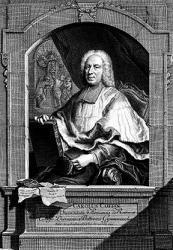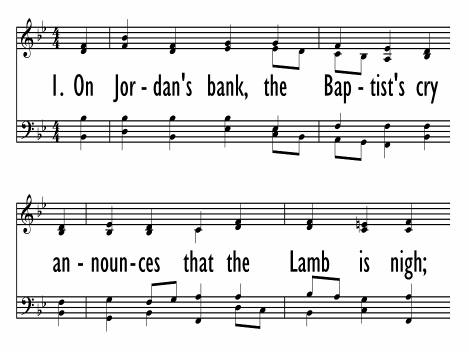Scripture References:
st. 1-2 = Isa. 40:3, 9, Matt. 3:3, Mark 1:3, Luke 3:3-4
st. 3 = Ps. 46:1, Isa. 40:7
John the Baptist's announcement "Prepare the way for the Lord" (Matt. 3:3, a quote from Isa. 40:3) is the primary basis for this Advent hymn. Stanzas 1 and 2 apply that message to people today; stanza 3 is a confession by God's people of their need for salvation; stanza 4 is a prayer for healing and love; stanza 5 is a doxology. This much-loved Advent text is laced with various scriptural phrases.
Charles Coffin (b. Buzancy, Ardennes, France, 1676; d. Paris, France, 1749) wrote this text in Latin (“Jordanis oras praevia”) for the Paris Breviary (1736), a famous Roman Catholic liturgical collection of psalms, hymns, and prayers. Coffin was partially responsible for the compilation of that hymnbook. Latin remained the language of scholarship and of the Roman Catholic liturgy in the eighteenth century. Working in that tradition, Coffin was an accomplished Latin scholar and writer of Latin poems and hymns. Educated at Deplessis College of the University of Paris, he served on the faculty and was university rector at the College of Doirmans-Beauvais, the University of Paris. He collected a hundred of his hymns and published them in Hymni Sacri (1736); a number of these have found their way into English language hymnals, including this Advent hymn.
The English translation is a composite work based on a translation by John Chandler (PHH 485), who published it in Hymns of the Primitive Church (1837). (Chandler thought it was a medieval text!) Since 1837, various hymnal editors have revised the text in attempts to bring the translation closer to Coffin's original.
Liturgical Use:
During Advent, especially in worship services on John the Baptist; sermons on repentance and renewal. The final stanza makes a fitting doxology for the four Sundays in Advent as well as for Christmas.
--Psalter Hymnal Handbook
===================
Jordanis oras praevia. C. Coffin. [Advent.] Published in his Hymni Sacri, 1736, p. 34; and again in the Paris Breviary the same year as the hymn for Sundays and Ferial days in Advent at Lauds. It is also in the Lyons and other Modern French Breviaries; Card. Newman's Hymni Ecclesiae, 1838 and 1865; and J. Chandler's Hymns of the Primitive Church, 1837, No. 37. It is translated as:—
1. On Jordan's bank the Baptist's cry. J. Chandler. First published in his Hymns of the Primitive Church, 1837, p. 40, in 6 stanzas of 4 lines. It is one of the most popular of Chandler's translations, and is given in a large number of hymn-books, those which contain the original translation however, being in the minority, and include the People's Hymnal, 1867, the Westminster Abbey Hymn Book, 1883, and the Universal Hymn Book, 1885. Of the numerous versions of the text, in most instances embodying slight alterations only, the best known are Murray's Hymnal, 1852; the Salisbury Hymn Book, 1857; Kennedy, 1863; Chope, 1864, &c. The most popular arrangement is that by the Compilers of Hymns Ancient & Modern. It appeared in their trial copy, 1859; and with another doxology in the 1st ed., 1861; and the revised edition, 1875. A few of the altered lines are taken from Murray s Hymnal , 1852, and the Cooke and Denton Hymnal, 1853. The most marked alteration is st. iv. "To heal the sick, stretch forth Thy hand." The following, together with others, give the Hymns Ancient & Modern text with further alterations: the Society for Promoting Christian Knowledge Church Hymns, 1871; the Hymnary, 1872: T. Darling's Hymns, &c, 1887, &c. The Rev. F. Pott's version in his Hymns, &c, 1861, and Prebendary Thring's in his Collection, 1882, are specially good. In the English Hymnal, 1856, and 1861, Chandler's text is altered to "On Jordan's banks a herald-cry;" and in the New Mitre Hymnal, 1875, No. 158, is a cento, stanzas i.-iii. "being from Chandler's translation, and stanzas iv., v. are Dr. Watts's version (L.M.) of Ps. 117, published in his Psalms of David, 1719, and not from his Hymns, &c, 1709, as stated by the editor.
2. Lo! the desert-depths are stirred. By W. J. Blew. Printed for use in his Church, circ. 1850, and published in The Church Hymn & Tune Book, 1852 and 1855. It was repeated in Face's Hymns, 1870.
3. Lo I the great Herald's voice. By Bishop J. R. Woodford. Contributed to the Parish Hymn Book, 1863; and repeated in the enlarged edition, 1875.
4. Behold the Baptist's warning sounds. By R. C. Singleton. Published in his Anglican Hymn Book, 1868, and again, after slight revision, in the 2nd ed. of the same, 1871.
Translations not in common use:—
1. Lo, the Baptist's herald cry. I. Williams, 1839.
2. Lo! the Prophet sent before. G. Rorison, 1851.
3. O, hark! through Jordan's echoing bounds. J. D. Chambers, 1857.
4. What sounds doth Jordan's streams appal. In O. Shipley's Annus Sanctus, 1884, by "W.M.A."
--John Julian, Dictionary of Hymnology (1907)


 My Starred Hymns
My Starred Hymns








